Archive for the ‘Education 2.0’ Category
Engage and Motivate Your Students with an Education Blog
Many teachers have been looking for a way to implement blogging into their classrooms. Amber Teaman, from Garland ISD, has a way for us to be able to do it. In her presentation, she shared with teachers a safe and easy solution on how to use blogging in the classroom and engage students in better ways.
A blog is an online journal (or web log) where you and others can post and comment on information. Blogs range from random thoughts about the world around us to serious education or research based information.
So how would you use it in your classroom? Ms. Teaman shared with us many ways she has used it in her classroom. To start out, she used the blog as a communication outlet for those stories that students wanted to share with her, that she just didn’t have time to listen to during class. By starting out this way, the students got comfortable answering questions the teacher posted in the blog and then also commenting on other student’s posts.
Read the original Story at eSchool – http://www.eschoolnews.com/cic/tcea/blog/2007/02/001636.php
Teachade: Online social networking for teachers

Educators who are looking for online sites to communicate and collaborate with their peers can register free of charge with Teachade, a site that lets educators share resources, create online learning communities, and connect with colleagues.
Teachade is available to K-12 teachers, pre-service teachers, student teachers, and college professors through a free registration process. The site uses Web 2.0 collaboration and social-networking technologies. Teachers can join groups formed around topics such as music, 6th-grade science, supporting educational technology, increasing student and child safety, and so on. Educators also have access to a personal and group calendar and can keep lesson plans or other items in personal “favorites” files.
eSchool News – Top 10 ed-tech stories of 2006
eSchool News recently had a two-part article on Top 10 Education Technology stories of 2006″, giving the ten most significant educational technology stories of the past year.
Original stories are at – Part 1 & Part 2
I had extracted some of them here:
Cell phones: The good, the bad, and the ugly
 Few technologies these days are as ubiquitous as the cell phone. But while parents rely on the portable devices to keep a bead on their children, and students use them to freely swap photos, music, and text messages with friends, the debate over the cell phone’s place in schools is heating up.
Few technologies these days are as ubiquitous as the cell phone. But while parents rely on the portable devices to keep a bead on their children, and students use them to freely swap photos, music, and text messages with friends, the debate over the cell phone’s place in schools is heating up.
In the classroom, some educators say the devices represent what amounts to a double-edged sword. While the growing list of interactive features–including cameras, video-capture technologies, and storage capabilities–have many educational technology advocates pushing schools to embrace the cell phone as a potentially powerful classroom learning device, resisters argue that cell phones represent a distraction and a potentially dangerous security risk that, if not held in check, could spell trouble for schools.
In a recent survey conducted by the Associated Press, America Online, and the Pew Internet and American Life Project, young adults indicated that they used their cell phones as mini-PCs. Not only do the devices make and receive phone calls, they said, but they also serve to store information, run basic computing applications, and swap music files, ring tones, pictures, and movies. Some educators said the results were encouraging and pointed to how cell phones could be used in the classroom to influence learning. In some schools, they already are: Boston University earlier this year reportedly became the first to introduce a class on using cell phones as video-production tools, and other colleges and universities are replacing telephone landlines with cellular services for students that include educational content.
But just as the survey shed light on the potential for cell phones in education, other, more troubling developments have served to mute that enthusiasm. For example, in one recent story, eSchool News reported on how students were using a high-pitched noise that only they can hear as a cell phone ring tone that is undetectable to most teachers. There also have been reports of students using cell phones to cheat on tests, take compromising pictures of classmates in school locker rooms, and socializing with friends– instead of learning–during the school day.
As the debate over cell phones in schools has evolved, so, too, have the policies intended to govern the use of such devices in schools. While some parents–anxious to have a method of reaching their child in the event of an emergency during the school day–have argued that policies barring cell phones from schools are out of touch with reality, several districts, including the New York City Public Schools, have taken steps to ban cell phones entirely for the risks they pose. In New York, parents have filed a lawsuit challenging the city’s policy.
One-to-one computing: Promising solution–or overhyped mistake?
One-to-one computing is another issue that continues to spark discussion–and debate–in education circles, particularly as developments in technology offer a range of new choices for schools.

Buoyed by the arrival of former MIT Media Lab Director Nicholas Negroponte’s $100 laptop–a low-cost, Linux-based machine designed to bring the power of educational technology to students in developing nations–advocates of one-to-one computing in schools contend that an emerging crop of affordable laptop alternatives are making the promise of one-to-one computing a fiscal reality for schools.
Earlier this year, Intel Corp. announced its own alternative to the $100 laptop, a $400 machine called Eduwise that, unlike Negroponte’s device, will be marketed immediately to U.S. schools.

In addition, Fourier Systems has introduced a new one-to-one computing device that 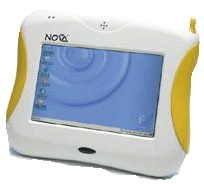 aims to “bridge the gap between the cost-prohibitive laptop and the less functional handheld device.” Weighing 2.2 pounds, the company’s Nova5000 is a Windows CE 5.0 tablet computing device that aims to meet students’ everyday computing needs, including internet access, word processing, spreadsheets, and eMail–starting at $419.
aims to “bridge the gap between the cost-prohibitive laptop and the less functional handheld device.” Weighing 2.2 pounds, the company’s Nova5000 is a Windows CE 5.0 tablet computing device that aims to meet students’ everyday computing needs, including internet access, word processing, spreadsheets, and eMail–starting at $419.
What’s more, a company called nComputing claims it can supply a one-to-one computing solution for schools for less than $100 per student, by fueling the computing needs of up to seven users off the processing power of a single machine.
Despite many new options that are driving down the cost of one-to-one computing, some parents and educators say there are still few measurable indicators to justify a large-scale, system-wide deployment, at least at current prices.
Though scaled-down alternatives might be appropriate for some learning environments, fully functional laptops remain cost-prohibitive in most school districts. Even for schools that can afford them, the question remains whether the price of the machines is too high for schools to optimize their investment.
As schools continue to demand more out of their technology purchases, the conversation about one-to-one learning in schools seems certain to continue in the New Year. The original site have many key stories they published on the topic in 2006.
7. 21st-century learning environments: Building schools of the future
As educators search for ways to prepare today’s students for the challenges of tomorrow’s workforce, school districts nationwide are doing more than simply changing the policies that govern how teachers teach; many are redesigning the traditional classroom altogether, building special learning environments–and even whole schools–designed to better prepare students for success in a global, knowledge-based economy.

In Philadelphia earlier this year, students and administrators celebrated the opening of the School of the Future. A joint venture between software giant Microsoft Corp. and the school district, the $63 million building–equipped with everything from wireless laptops and electronic whiteboards to energy-efficient windows and customizable furniture for project-based learning environments–was touted as a cost-effective model that other schools around the nation could emulate as they sought to redesign today’s high schools for the 21st century.
Philadelphia isn’t the only place where architecture and philosophy have come together to redefine the notion of the typical American schoolhouse. Across the country, design firms have been working closely with educators to reconfigure traditional learning environments to reflect the needs of 21st-century learners.

And the movement toward redesigning education for the 21st century got a huge boost last summer, when billionaire investor Warren Buffet announced a contribution to the Bill and Melinda Gates Foundation, a strong supporter of the concept, totaling about $1.5 billion a year.
6. Social-networking web sites challenge policy makers

The growth of social-networking web sites such as MySpace.com, the popular online community that connects millions of users with friends around the world by enabling users to post their personal profiles online, continued to confound school leaders and state and federal policy makers in 2006. Though the sites present an opportunity for peer collaboration and cross-cultural exchanges among students, they also have become trolling places for online predators and hotspots for cyber-bullying.
According to a recent survey conducted by the National School Boards Association, only 35 percent of the educators, administrators, and school board members who attended the group’s Technology + Learning Conference in November said their districts had policies to address the use of social-networking sites by their students. Fifty percent of respondents said their districts had no such policies, and 15 percent weren’t sure.
School leaders aren’t the only ones struggling with how to protect students who use social-networking web sites. Members of Congress introduced a bill that would ban the use of MySpace and other such sites in schools and public places, prompting outrage from some educators who believed the bill went too far. MySpace itself has taken steps to enhance security, though critics of the measures question whether they will be effective.
Despite the challenges these sites pose for schools, proponents of online social networking say the sites, when used effectively, can be educationally beneficial.
5. Online learning comes of age, multiplying the opportunities available to students and teachers.
The past year saw an explosion in online learning programs for teachers and students, continuing a trend that some experts predicted would begin to level off.
Instead, according to a report from the North American Council for Online Learning, enrollment in K-12 online classes grew by more than 50 percent in some states–and at least 38 states now feature either state-led online learning programs, policies regulating online education, or both. In higher education, the story was the same: According to the Sloan Consortium, which tracks online enrollment figures at higher-education institutions annually, online enrollment was up 40 percent over the previous year.

Educators say the trend is fueled by several factors. In some states, schools are using online learning as a way to reach out to students who are sick or cannot attend neighborhood schools. (To facilitate this, the nonprofit Virtual High School launched a pilot program earlier this year that is offering virtual-school seats at no cost to three children’s hospitals–and the group hopes to expand the program to other hospitals nationwide.) In other places, virtual-school programs provide an alternative for students whose needs aren’t being met by a traditional education. (At Stanford, educators have developed an online high school for gifted and talented students interested in taking more advanced, college-level courses. And in Mississippi, to curb a high school dropout rate that is among the highest in the country, state education officials are proposing a self-paced, online curriculum as one solution.)
Earlier this year, Michigan became the first state in the nation to make virtual learning a requirement for high school graduation. And as online learning has exploded in popularity, at least two groups–the Southern Regional Education Board and the National Education Association–have released standards defining excellence in online teaching.

One recent development that will help push online learning to even further heights is the Sharable Content Object Reference Model, or SCORM, an emerging set of standards designed to promote interoperability, accessibility, and reusability of online learning materials. Proponents say the specifications should help schools integrate any SCORM-compliant digital content into their existing learning management systems (LMS), regardless of manufacturer.
The emergence of SCORM is making innovative experiments like the one in California possible, where a new program under way in select elementary schools has history teachers scrapping traditional textbooks in favor of digital learning materials. But despite this progress, an ongoing patent dispute between leading online LMS provider Blackboard Inc. and its competitors threatens to cast a cloud over the LMS market.
4. Video goes ‘viral,’ expanding the reach of college lectures–and turning ordinary students into internet celebrities.

Last year it was MySpace that exploded onto the internet scene, forever changing the nature of the web. This year, it was the video-sharing web site YouTube. Providing users with the ability to upload and share their own videos easily online netted YouTube’s creators $1.6 billion when the site was purchased by Google Inc. earlier this year–and it has made internet celebrities out of countless teens armed only with video cameras and a little imagination. As author and inventor Ray Kurzweil noted at the National School Boards Association’s annual Technology + Learning Conference in November, this kind of technology “is very empowering; it’s very democratizing.”
YouTube was merely the most high-profile example of a trend that really flourished in 2006: the rise in online video, which has had enormous implications for schools. Besides helping students become creators and publishers of their work, the emergence of YouTube, Google Video, and other online video-sharing services has given schools a wide array of new tools to help them connect with today’s crop of media-savvy learners.
Looking to include the use of video more in the learning process, innovative educators in Missouri recently launched a new online television network that delivers educational content via IP-TV. Many schools, and now even some entire conferences, have begun streaming football games and other sporting events on their web sites, eliminating barriers such as cable or satellite TV availability or advertising support. And the development of the video iPod has opened new doors for schools to make video recordings of lectures and other content available to students for downloading and watching at their leisure.
For instance, at the University of California, Berkeley, students and others all over the world now can access a special account through Apple’s iTunes U, where they can download webcasts of lectures and other events on campus to their desktop, laptop, or portable iPod. Many colleges and universities also have tapped video as a way of reaching out to prospective students, using online tours and other video resources as a recruiting tool to lure students who otherwise might not be able to visit the campus in person.
Even eSchool News has seized upon the online video trend. Earlier this year, eSN launched TechWatch, a free monthly video news program that reports on ed-tech news from around the nation. The program is available via streaming video online–but it’s also available in other digital formats for school systems to broadcast over their local cable channels.
3. Education 2.0 has arrived: The emergence of web-based services and other open technology alternatives is changing the nature of school software.
Hoping to lure teachers and students, thus capturing the attention of a whole new generation of users, Google–the world’s largest internet company–this year launched an online portal for educators, complete with lesson plans and other resources designed to help educators use the company’s free online tools (such as Google Docs and Spreadsheets, an open alternative to Microsoft’s Word and Excel) in their classes. The site also contains resources for using Google Maps in education, and Google last month ran an online project encouraging students from around the globe to brainstorm ways to slow or stop global warming–using the company’s software to collaborate.
Google is perhaps the largest, but it’s by no means the only, example of how the emergence of free, or low-cost, web-based services and software is changing the nature of school computing. For years, schools have been using web-based software for their data systems, administrative systems, and even their curriculum software–and students and teachers have used web-based eMail accounts. But now, even applications that traditionally have been tethered to a desktop computer, such as productivity tools–spreadsheets, word processors, and the like–can be accessed entirely online. And many of these tools are available to use or license free of charge.
Besides the obvious bottom-line benefit these open technology alternatives to costly proprietary software offer, educators say the services also enable them to customize their digital learning environments more easily–providing a host of resources designed to meet the needs of teachers and students, regardless of platform. Web-based tools also allow users to collaborate on the same documents from different locations. But there are some challenges, too: Using web-based software requires a constant and reliable internet connection, for instance–and some people also are concerned about the privacy of information held in sign-in accounts stored on company servers.

Original Article Published in ZDNet Asia, June 29, 2000
by Anita Devasahayam
 LUMUT, Malaysia: You may not find the Dindings High School, located in the hinterland of Malaysia’s northern state of Perak, on any map, and may pass it by without a second thought.
LUMUT, Malaysia: You may not find the Dindings High School, located in the hinterland of Malaysia’s northern state of Perak, on any map, and may pass it by without a second thought.
But located within its wooden walls and under zinc roofs are budding entrepreneurs of the new dot-com world.
The 800 students of the school, ranging in ages between 13 and 17, surf the Internet, learn Web design, digital art, networking, and programming in C, Visual Basic, Linux and Unix as part of their daily curriculum.
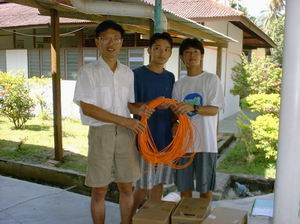
In their most recent school project, a group of 20 students received hands-on experience in laying a one-km 10Mbps fiber-optic cable to inter-link the school with a nearby primary school and kindergarten. The campus-wide high-band network was probably the first of its kind in the country that was commissioned and maintained by teenagers. The new link-up will enable students and teachers to experiment with classroom-to-classroom video-conferencing and other multimedia applications.
“By the time these students leave school, they will have enough technical know-how and skills to configure and use switches and hubs and manage networks,” said principal Tiong Ting Ming who is the driving force behind the rural school’s transformation.
Eight years ago, the radical 48-year-old principal, was assigned to the Dindings school located near the beachfront town of Lumut, where the community’s lives are mostly centered around trading, fishing and agriculture.
Tiong had come with the belief that the textbook-reliant, exam-oriented education system the school was governed by was not enough to equip his students to participate in a globalized economy. Added to that the less-motivated students were dropping out and he needed to stem the tide.
An Apple Macintosh fan, Tiong was switched on by the opportunities that computing technology could give his young charges. “One of the hardest things was convincing some of the more skeptical parents and technophobic teachers that computers are necessary to give the kids skills they could use in the real world,” he said.
When the Internet came along, it served to reinforce Tiong’s belief that he needed to arm his students for the future knowledge workplace. “The Internet is their future. I was convinced educating them to be responsible Net citizens and giving them the right skill sets had to start in school,” he said.
Persistence pays
A chemistry graduate, Tiong set about teaching himself to repair and upgrade old PCs and cajoled teachers and students to embrace the Internet. Only partially supported by government and without the cash-rich opportunities of urban schools, Tiong knocked on doors of corporations and benefactors to win them over.
“I visited one company in Kuala Lumpur seven times before they finally relented and gave me the first set of PCs and Macs to get us started,” said Tiong.
He also travelled personally on 800-km bus journeys to-and-fro Singapore to purchase spare parts to refurbish second-hand computers for his students. “Computer parts are expensive in Malaysia and are much cheaper from bargain hardware purveyors at Sim Lim Square in downtown Singapore,” he said.
With the aid of former-students, some generous individual donors, various companies, and the Ministry of Education, the school has since raised over 1.8 million ringgit (US$470,000), in cash and kind, to fund its efforts to build up a networked environment from scratch.
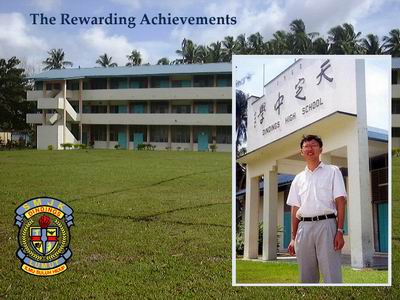
Wedged between a palm oil estate and a coconut plantation, the school now boasts a brand new three-storey block that is a hive of computing activity. Tiong’s office is more akin to a computer retail shop’s back-office, and is packed with an assortment of PCs, servers, peripherals, cables and an over-laden shelf filled with phonebook-sized technical manuals and books.
His open-door policy, during this interview, saw busy students come in armed with some component or another, then skitter off spouting geekspeak. Amid the clutter in the room there is even a bed to get some shut-eye and a fridge for snacks when his students are working on late-night “projects.”
One of those projects, administered by Tiong, was the wiring of the entire school including the classrooms, the library, the staff room, the administration office and computer labs.
The school now has over 100 PCs – 486s, Pentium 75s and Pentium MMX 166s – that give students and teachers instant access to the Internet via a 64Kbps leased line.
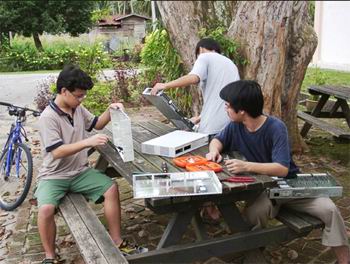
A cadre of trained students upkeep the PCs and administer the Dell 553MHz dual -processor main server, and a self-configured secondary and backup server.
The Red Hat Linux 6.1 powered-server houses their mail server, Apache Web server, proxy server, newsgroups, Internet Relay Chat, and file, print and backup server.
‘I chose Linux because the system cost me only 200 ringgit and was useful for my students to learn and configure,” he said.
Sowing the Net generation
Early last year, Tiong yanked biology as a subject from the curriculum for his Form Four (16-year-old) students and replaced it with information technology. “Better to know the innards of a computer than human or animal anatomy,” he thought.
He has since extended the subject school-wide, and all students have their own individual email and attend varied courses ranging from basic software to hardware troubleshooting and maintenance, programming, local area networking, and structured cabling and certification.
Students are also assigned projects by teachers to encourage them to do research on the Internet to complement their traditional subjects.
This year, a pioneer batch of 120 students will be taking Information Technology as an exam subject for the year-end compulsory government examinations, that is a prerequisite for university entrance.
Networking giant 3Com Corp adopted Dindings as the first of 11 schools in the country for its global NetPrep program to provide students with network management skills.
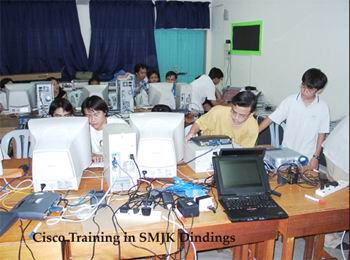
The first batch of 20 students are currently undergoing 160-hours of the intensive program and will be certified by the International Association of Communication Systems Engineers upon completion.
Tiong believes the hard work has begun to pay off. “I used to have to persuade parents to keep their children in school. Now I get queries from far and wide to have their children sent here,” he said. The student population has grown steadily, in tandem with the school’s computing firepower, from 320 to the present 800.
He discloses that school’s passing rate in year-end exams, a government barometer for a school’s success, is still only around 50 percent. “But their environment is sheltered. Introducing the Internet to the students has opened their minds tremendously and given them insights and the motivation to be discerning and analyze information,” he said.
Tiong said his ultimate goal is to provide an environment where the “Net culture” can thrive. He hopes students can be imprinted with a self – and life-long learning trait that they could retain beyond school walls.
He added that teachers in the country need to bone up to adapt to the rapidly shifting educational needs of students. “Teachers are at risk of becoming obsolete if they do not understand nor accept that they no longer hold a monopoly over the input their students receive. They must become as Net-savvy as their students. You can ignore the technology, but not the information,” he said.
Tiong is convinced the information technology skills his students acquire will equip them for life in the real working environment and to be more responsible with the use of the technology. It may even inspire some to become entrepreneurs. As Tiong puts it: “You can either be a paddy planter or rice eater. I am teaching my kids to be planters because that’s their future ricebowls.”

Published in ZDNet Asia
by Anita Devasahayam